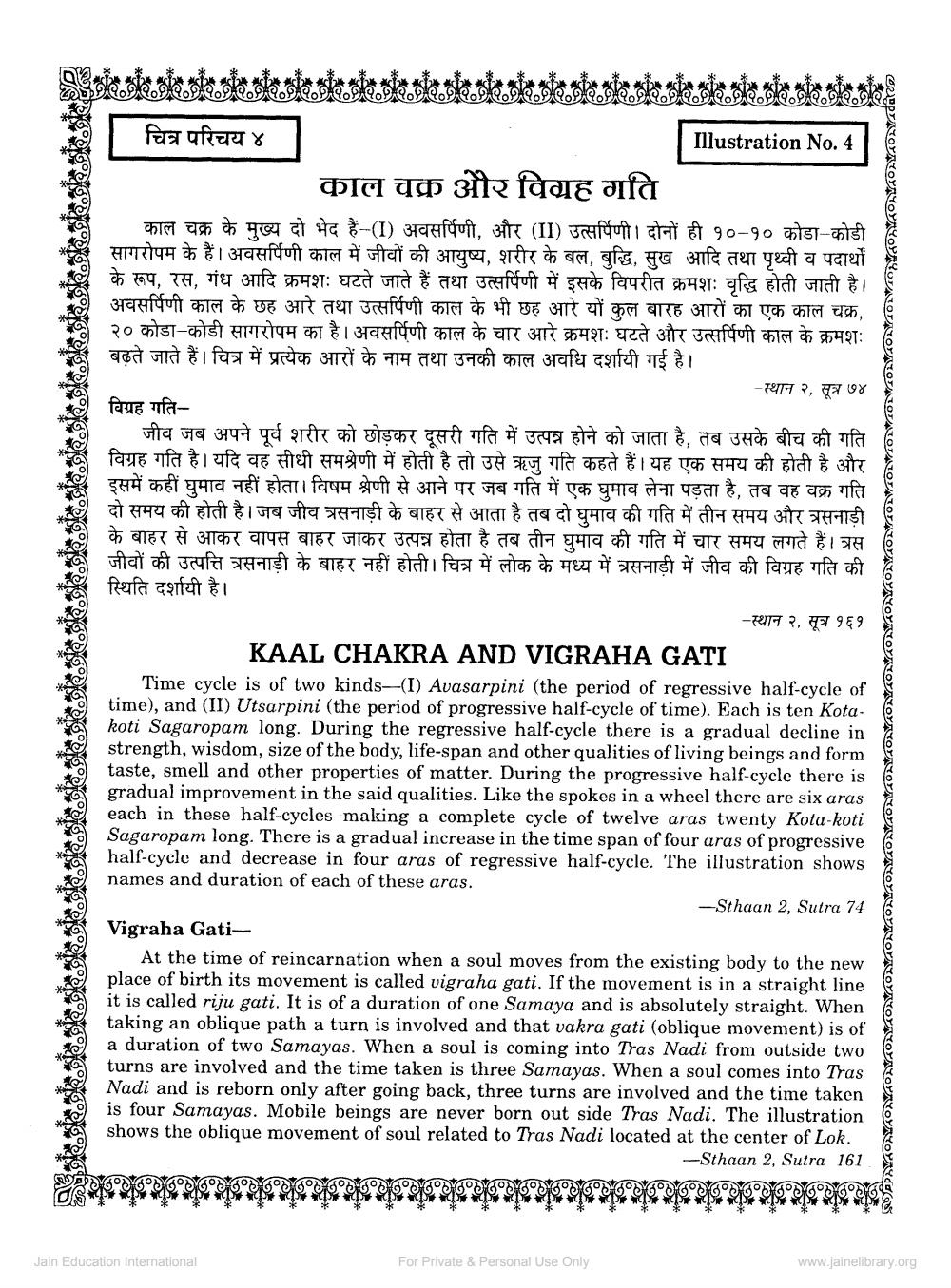________________
8
चित्र परिचय ४ ।
Illustration No. 4 काल चक्र और विग्रह गति काल चक्र के मुख्य दो भेद हैं-(I) अवसर्पिणी, और (II) उत्सर्पिणी। दोनों ही १०-१० कोडा-कोडी सागरोपम के हैं। अवसर्पिणी काल में जीवों की आयुष्य, शरीर के बल, बुद्धि, सुख आदि तथा पृथ्वी व पदार्थों के रूप, रस, गंध आदि क्रमशः घटते जाते हैं तथा उत्सर्पिणी में इसके विपरीत क्रमशः वृद्धि होती जाती है। अवसर्पिणी काल के छह आरे तथा उत्सर्पिणी काल के भी छह आरे यों कुल बारह आरों का एक काल चक्र, २० कोडा-कोडी सागरोपम का है। अवसर्पिणी काल के चार आरे क्रमशः घटते और उत्सर्पिणी काल के क्रमशः बढ़ते जाते हैं। चित्र में प्रत्येक आरों के नाम तथा उनकी काल अवधि दर्शायी गई है।
-स्थान २, सूत्र ७४ विग्रह गति
जीव जब अपने पूर्व शरीर को छोड़कर दूसरी गति में उत्पन्न होने को जाता है, तब उसके बीच की गति विग्रह गति है। यदि वह सीधी समश्रेणी में होती है तो उसे ऋजु गति कहते हैं। यह एक समय की होती है और इसमें कहीं घुमाव नहीं होता। विषम श्रेणी से आने पर जब गति में एक घुमाव लेना पड़ता है, तब वह वक्र गति दो समय की होती है। जब जीव त्रसनाड़ी के बाहर से आता है तब दो घुमाव की गति में तीन समय और त्रसनाड़ी के बाहर से आकर वापस बाहर जाकर उत्पन्न होता है तब तीन घुमाव की गति में चार समय लगते हैं। त्रस जीवों की उत्पत्ति त्रसनाड़ी के बाहर नहीं होती। चित्र में लोक के मध्य में त्रसनाड़ी में जीव की विग्रह गति की स्थिति दर्शायी है।
-स्थान २, सूत्र १६१ KAAL CHAKRA AND VIGRAHA GATI Time cycle is of two kinds-(I) Avasarpini (the period of regressive half-cycle of time), and (II) Utsarpini (the period of progressive half-cycle of time). Each is ten Kotakoti Sagaropam long. During the regressive half-cycle there is a gradual decline in strength, wisdom, size of the body, life-span and other qualities of living beings and form taste, smell and other properties of matter. During the progressive half-cycle there is gradual improvement in the said qualities. Like the spokes in a wheel there are six aras each in these half-cycles making a complete cycle of twelve aras twenty Kota-koti Sagaropam long. There is a gradual increase in the time span of four aras of progressive half-cycle and decrease in four aras of regressive half-cycle. The illustration shows names and duration of each of these aras.
-Sthaan 2, Sutra 74 Vigraha Gati
At the time of reincarnation when a soul moves from the existing body to the new place of birth its movement is called vigraha gati. If the movement is in a straight line it is called riju gati. It is of a duration of one Samaya and is absolutely straight. When taking an oblique path a turn is involved and that vakra gati (oblique movement) is of a duration of two Samayas. When a soul is coming into Tras Nadi from outside two turns are involved and the time taken is three Samayas. When a soul comes into Tras Nadi and is reborn only after going back, three turns are involved and the time taken is four Samayas. Mobile beings are never born out side Tras Nadi. The illustration shows the oblique movement of soul related to Tras Nadi located at the center of Lok.
-Sthaan 2, Sutra 161
SOGRAVAORMAORMAORYAORMAODAMAORYAAVARTAORMAORTAORTAORMAORTAORMAONVADYARTHORVADIYAOINOWoroMORYAORTIONORMAAVAORVAOAVAORadio
For Private & Personal Use Only
Jain Education International
www.jainelibrary.org




